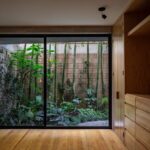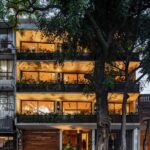In the vibrant Roma district of Mexico City, the Chiapas 168 Building stands as a testament to modern residential architecture, blending seamlessly with its natural surroundings. Nestled beside a majestic jacaranda tree, this development comprises four residential apartments, each designed to harmonize with the lush environment.
Architectural Features
A striking feature of the Chiapas 168 Building is the integration of steel planters and balconies, intertwining with the branches of the ancient jacaranda tree. These balconies offer residents a unique connection to nature, allowing them to immerse themselves in the beauty of purple flowers and fragrant jasmine.

Internal Layout
The building’s internal layout is characterized by a core system of vertical circulation, separating communal areas from private spaces. A central stairwell bathed in sunlight serves as the focal point, offering residents a tranquil transition between levels. Wooden finishes and floor-to-ceiling shelving provide privacy in intimate areas while maintaining an open-plan design in communal spaces.

Embracing Nature
To the south, a curtain of bamboo creates a natural barrier, shielding the back garden from external views and diffusing sunlight to create a serene atmosphere. The translucent leaves of the bamboo rustle in the wind, evoking the soothing sound of raindrops.

Sustainable Design
Integral to the design philosophy of the Chiapas 168 Building are its rooftop gardens, serving as vibrant hubs of biodiversity. By embracing the presence of other organisms within urban environments, the building promotes sustainability and ecological awareness in densely populated cities.

Conclusion
The Chiapas 168 Building exemplifies the seamless integration of modern architecture with nature, offering residents a tranquil sanctuary in the heart of Mexico City’s bustling Roma district. With its thoughtful design, sustainable features, and commitment to preserving the natural environment, it sets a new standard for urban living.














